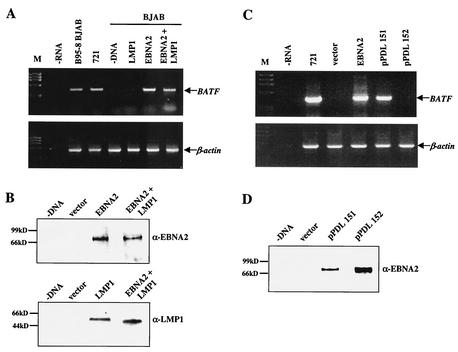FIG. 4.
The BATF gene is a target for transactivation by EBNA2. (A) BJAB cells were electroporated as described in Materials and Methods with 10 μg of each indicated plasmid DNA (20 μg of total DNA in each group). Total RNA was isolated after 48 h and analyzed for BATF expression and control β-actin gene expression by RT-PCR. RNA isolated from EBV-infected BJAB cells (B95-8 BJAB) and 721 B cells provided positive controls. A no-RNA reaction (−RNA) and a control BJAB reaction (−DNA) served as the negative controls. ØX174 HaeIII DNA (M) provided a marker for molecular weight. (B) Immunoblot analysis of EBNA2 and LMP1 protein expression in cell extracts prepared from BJAB cells electroporated as described for panel A with the indicated expression plasmids. The migration of molecular mass protein markers is indicated to the left of each autoradiography gel. (C) BJAB cells were electroporated as described for those in panel A with two EBNA2 expression plasmids (EBNA2, pPDL151) and a plasmid directing the production of a nontransactivating EBNA2 variant (pPDL152). Total RNA was isolated after 48 h and analyzed for BATF and β-actin mRNA expression by RT-PCR. RNA from 721 cells served as the positive control. A no-RNA (−RNA) reaction and RNA from BJAB cells electroporated with empty vector DNA served as negative controls. ØX174 HaeIII DNA (M) provided a molecular weight marker. (D) Immunoblot analysis of EBNA2 protein expression in the indicated groups analyzed for BATF gene expression as for that in panel C. The migration of molecular mass protein markers is indicated to the left of the autoradiography gel.

